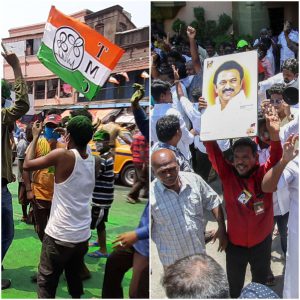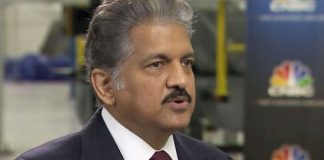MAY 2, 2021

Chief minister Mamata Banerjee’s Trinamool Congress (TMC) scored an emphatic win in the keenly watched assembly elections in West Bengal, MK Stalin’s Dravida Munnetra Kazhagam (DMK) returned to power in Tamil Nadu after a decade, and Kerala’s Left government scripted history by winning two consecutive terms on Sunday, putting an end to a month-long polling exercise that was held under the shadow of the Covid-19 pandemic.
The Bharatiya Janata Party (BJP) was poised to return to power for a second straight term in Assam, while its alliance was ahead in the Union Territory (UT) of Puducherry — the silver lining for the saffron camp that suffered a heavy defeat at the hands of the TMC in the most-talked-about poll battle since the 2019 Lok Sabha elections. Another national party, the Congress, had nothing significant to showcase in this round of elections, apart from ally DMK’s Tamil Nadu win.
In Bengal, the BJP looked set to end below the three-figure mark, as claimed by Banerjee’s party consistently during the fiercely fought elections. While the TMC’s victory was sound — the party was on course to bettering its 2016 tally of 211 seats — the chief minister herself lost Nandigram in a see-saw poll battle against former lieutenant Suvendu Adhikari (he won the seat in 2016 as a TMC candidate). But that might not stop Banerjee’s advancement to the forefront of the political bloc opposing the Centre’s ruling BJP, given the scale of the TMC’s overall victory in a high-stakes election.
“I would think that there’s been a vote against the BJP. We must also accept that national leaders, while popular, may not have the same acceptability in regional politics,” said political commentator Shutapa Paul, the author of Didi: The Untold Mamata Banerjee.
The TMC’s political strategist, Prashant Kishor, had a similar take. “…People have reposed their faith in her (Banerjee)…Being a central minister and the arrival of big leaders (for campaigning) don’t guarantee a poll victory,” he told CNN-News18’s television channel exclusively, when asked how the TMC pulled off such a spectacular showing despite Prime Minister Narendra Modi and Union home minister Amit Shah’s poll campaigns in the battleground state.
Compared with its 2016 performance (three seats and a vote share of 10%), the BJP took significant strides in Bengal (it might settle with 70-80 seats and a vote share of close to 38%). But expectations surrounding the BJP had risen after the 2019 national elections, in which it bagged 18 of Bengal’s 42 Lok Sabha seats with a vote share of little over 40%. According to observers, the assembly results would be interpreted as a setback to the BJP, which had itself set a target of winning at least 200 of Bengal’s 294 assembly seats.
“It’s time for the BJP to go into deep introspection. It appears that the TMC not only got votes of those who were happy with the government but also of those who simply wanted to see the BJP defeated. The TMC has now recorded the highest vote share (around 48%) it ever achieved since the birth of the party in 1998, as a visible anti-BJP polarisation happened around the TMC,” journalist Snigdhendu Bhattacharya, the author of Mission Bengal: A Saffron Experiment, said.
BJP national vice-president Jay Panda underlined that the party had set very “high targets” in Bengal, where it claimed the opposition space with the rout of the Congress-Left alliance. “…even in Bengal, even though we had set very high targets, going from three seats to nearly triple digits is a huge growth…And now it has become a bipolar situation in Bengal…,” he told CNN-News18’s TV channel.
PM Modi, Union ministers, and leaders such as Nationalist Congress Party (NCP)’s Sharad Pawar and the Aam Aadmi Party (AAP)’s Arvind Kejriwal congratulated Banerjee on her party’s win, which could bolster the voices against the BJP.
“…she (Banerjee) took on the consolidated might of the BJP machinery and delivered a resounding victory. Mamata Banerjee definitely leads the opposition bloc along with (Maharashtra chief minister) Uddhav Thackeray and, to some measure, (Delhi chief minister) Arvind Kejriwal,” Paul said.
On the southern front, the DMK’s alliance was set to return to power after 10 years, but analysts said the “tsunami” that party president Stalin had expected did not occur. The 2021 elections in the state were a direct fight between Stalin and outgoing chief minister Edappadi K Palaniswami, or EPS, in the absence of the colossal M Karunanidhi of the DMK and the charismatic J Jayalalithaa of the All India Anna Dravida Munnetra Kazhagam (AIADMK).
According to senior journalist R Bhagwan Singh, the “big message from the poll results in Tamil Nadu” was that Palaniswami “has established himself as the political heir to the late Amma (as Jayalalithaa was popularly called)”. Not only did EPS manage to keep the AIADMK flock together after the death of Jayalalithaa in December 2016 but he also “has done fairly well even in this defeat”, Singh said.
“He has been able to avert the rout that most opinion/exit polls predicted for his party…the DMK’s victory was very much expected, but the widely predicted sweep did not happen…the sole credit for that must go to EPS as he shouldered the entire burden of the AIADMK campaign across Tamil Nadu; his voice turned hoarse in the final days of the high-decibel electioneering while all other party leaders and ministers were confined to their own constituencies,” Singh said.
A win in neighboring Puducherry, he explained, would help the BJP in its bid for Tamil Nadu in the future. By Sunday evening, the alliance involving the BJP and the All India NR Congress was close to the majority mark in the UT, which has 30 seats.
“The saffron scheme, unfolded by party heavyweights at their campaign rallies in the Union Territory, is to pump in massive central funds for infrastructure and developmental projects that could boost the economy of the tiny patch of land that’s not much larger than a district in adjoining Tamil Nadu.
“The BJP hopes to win over the Dravidian voter in the neighboring state in the 2026 polls by parading the Puducherry model. However, a lot depends on the party succeeding in its plan to improve and increase its cadre base in Tamil Nadu…,” Singh said.
The BJP camp would also find a reason to cheer in the Assam election results. A second straight win there meant the party was successful in navigating the tricky corridors of identity politics, especially in the aftermath of controversies surrounding the Citizenship (Amendment) Act and the National Register of Citizens (NRC). It also meant the north-eastern state for the first time elected a non-Congress government for two consecutive terms.
“…there was a tremendous breakthrough five years ago. And now, five years later, the pro-incumbency atmosphere that prevailed has some very important reasons behind it, and it does prove that the BJP makes a huge difference in governance,” BJP leader Panda, who is also the party’s incharge for Assam, said.
History was made in Kerala too with chief minister Pinarayi Vijayan — he received praises for responding promptly to the deadly floods in 2018 and to the coronavirus pandemic —steering the Left to power for the second consecutive term in the state that has traditionally changed its government every five years. The win also kept communists relevant in electoral democracy, as Kerala is the only state that the Left holds.
At the same time, the results in Kerala were being interpreted as another setback to the embattled Congress, which is already reeling from a series of poll debacles and internal dissent.
“The people have realised that the LDF (Left Democratic Front) government followed a pro-people policy,” MA Baby, a politburo member of the Communist Party of India-Marxist, or CPI-M, told CNN-News18’s TV channel.
Singh, former editor at the Asian Age, said the big message for the BJP from this round of elections was that it “would do well to recalibrate its strategies for regional politics and dilute the dependency on the central leadership”, while the Congress needed to have a rethink on the leadership issue.
“…the BJP must strengthen its state-level leadership and allow regional satraps free hand to build the organisation by taking into account local sentiments, issues, language and culture. The other national party, the Indian National Congress, needs to urgently undertake hard introspection on its leadership crisis. Otherwise, it might just get reduced to a regional status,” he said.
Singh added that the second term for Vijayan as well as the Congress’s likely debacle in Puducherry, despite senior party leader Rahul Gandhi’s campaigns there, “must trigger the long-delayed search for strong leadership in the party”.
Courtesy/Source: News18










































































































